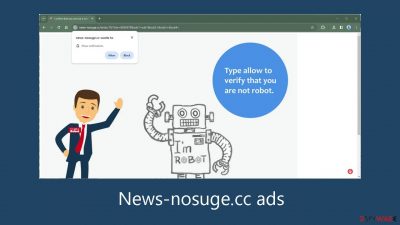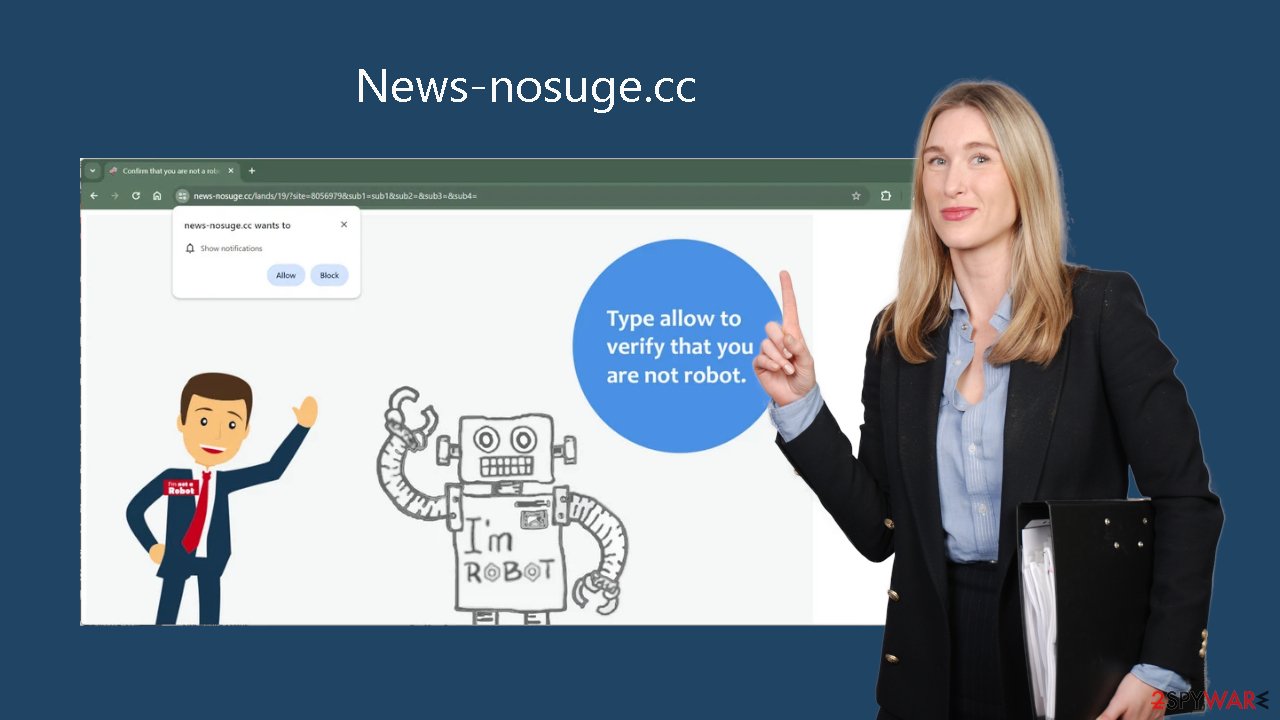News-nosuge.cc ads (spam) - Free Instructions
News-nosuge.cc ads Removal Guide
What is News-nosuge.cc ads?
News-nosuge.cc is a dubious site that collects revenue from push notifications

News-nosuge.cc is a fraudulent website created by crooks with the intent of profiting through pay-per-click advertisements. By using social engineering[1] techniques, the page asks visitors to click the “Allow” button in order to confirm that they are not robots in order to trick them into subscribing to push notifications.
When users allow access, the website bombards them with invasive pop-up advertisements that continue to show even after the browser is closed. Additionally, fraudsters may exploit rogue advertising networks[2] to embed links to harmful websites within their ads. Users who click on these links may be sent to more fraudulent websites.
Crooks frequently use a variety of techniques to trick people into installing malware or potentially unwanted programs (PUPs).[3] Many users have reported seeing adverts for surveys, fake giveaways, adult websites, fake antivirus software, and software deals. See our detailed tutorial for step-by-step instructions on how to get rid of these unwanted invaders.
| NAME | News-nosuge.cc |
| TYPE | Push notification spam; adware |
| SYMPTOMS | Annoying pop-up ads start appearing in the corner of the screen, sometimes even when the browser is closed |
| DISTRIBUTION | Shady websites, deceptive ads, freeware bundling |
| DANGERS | Links embedded in the pop-ups may lead to dangerous pages where people can get tricked into providing their personal information or downloading PUPs and malware |
| ELIMINATION | Disable push notifications via browser settings |
| FURTHER STEPS | Use a maintenance tool like FortectIntego to clear your browsers from cookies and cache |
Distribution methods
Search engines do not often provide pages like News-nosuge.cc. They are more often discovered on dubious sites with no real regulation. For example, illegal streaming websites frequently include a lot of misleading advertisements and secretly reroute customers. In addition, these streaming services frequently include fake “Download” or “Play” buttons that mimic real ones in an attempt to trick users into clicking and inadvertently opening new tabs.
Visit only well-known and reliable websites to protect your online safety. Even if an advertisement or link seems to be promoting a legitimate product or service, stay away from clicking on it. Rather, use trustworthy streaming services like Hulu or Netflix. While they may entail a modest monthly subscription fee, users can enjoy unlimited content without compromising their online security.

Clear your browsers
It's probable that you'll see requests to accept cookies when using the internet. Cookies are little data files that store information about your IP address, location, websites you visit, and links you click. In spite of initial concerns, this approach lets website owners customize the customer experience.
However, crooks could use this information to their financial advantage if it ends up in the wrong hands. Cookies can be used for malicious reasons, especially on websites with weak security safeguards. They can also be sold to advertising networks or other third parties. It's essential to routinely delete the cookies from your browser because of these concerns.
With tools like FortectIntego, which can quickly erase all cookies and cache with a single click, automating this procedure is simple. It also takes care of system problems including errors, BSODs, corrupted files, and registry issues – particularly helpful following a virus infection.
How to disable pop-ups?
The first thing you should do is go to your browser settings and see if you can disable the push notifications from there:
Google Chrome (desktop):
- Open Google Chrome browser and go to Menu > Settings.
- Scroll down and click on Advanced.
- Locate Privacy and security section and pick Site Settings > Notifications.
![Stop notifications on Chrome PC 1 Stop notifications on Chrome PC 1]()
- Look at the Allow section and look for a suspicious URL.
- Click the three vertical dots next to it and pick Block. This should remove unwanted notifications from Google Chrome.
![Stop notifications on Chrome PC 2 Stop notifications on Chrome PC 2]()
Google Chrome (Android):
- Open Google Chrome and tap on Settings (three vertical dots).
- Select Notifications.
- Scroll down to the Sites section.
- Locate the unwanted URL and toggle the button to the left (Off setting).
![Stop notifications on Chrome Android Stop notifications on Chrome Android]()
Mozilla Firefox:
- Open Mozilla Firefox and go to Menu > Options.
- Click on Privacy & Security section.
- Under Permissions, you should be able to see Notifications. Click the Settings button next to it.
![Stop notifications on Mozilla Firefox 1 Stop notifications on Mozilla Firefox 1]()
- In the Settings – Notification Permissions window, click on the drop-down menu by the URL in question.
- Select Block and then click on Save Changes. This should remove unwanted notifications from Mozilla Firefox.
![Stop notifications on Mozilla Firefox 2 Stop notifications on Mozilla Firefox 2]()
Safari:
- Click on Safari > Preferences…
- Go to the Websites tab and, under General, select Notifications.
- Select the web address in question, click the drop-down menu and select Deny.
![Stop notifications on Safari Stop notifications on Safari]()
MS Edge:
- Open Microsoft Edge, and click the Settings and more button (three horizontal dots) at the top-right of the window.
- Select Settings and then go to Advanced.
- Under Website permissions, pick Manage permissions and select the URL in question.
![Stop notifications on Edge 1 Stop notifications on Edge 1]()
- Toggle the switch to the left to turn notifications off on Microsoft Edge.
MS Edge (Chromium):
- Open Microsoft Edge, and go to Settings.
- Select Site permissions.
- Go to Notifications on the right.
- Under Allow, you will find the unwanted entry.
- Click on More actions and select Block.
Adware removal
Adware can still be present on your system even after you have blocked notifications; it will show up as more commercial content, like banners, pop-ups, surveys, and redirects. We highly advise doing a comprehensive system scan on your computer using reputable security software like SpyHunter 5Combo Cleaner or Malwarebytes if you are experiencing any of these symptoms.
Using antivirus software, you may find and terminate suspicious processes on your computer, along with any related files. It also acts as a safeguard, warning you of possible dangers when you download dubious content. Manual removal is an alternative, but it can be difficult to recognize potentially unwanted programs (PUPs) because they frequently pose as media players, antivirus software, or system optimizers, among other seemingly helpful utilities.
Manual removal may also pose the risk of incomplete elimination, leading to a potential resurgence of the infection. However, if you opt for manual removal, detailed instructions for both Windows and Mac systems are provided below:
Windows 10/8:
- Enter Control Panel into Windows search box and hit Enter or click on the search result.
- Under Programs, select Uninstall a program.
![Uninstall from Windows 1 Uninstall from Windows 1]()
- From the list, find the entry of the suspicious program.
- Right-click on the application and select Uninstall.
- If User Account Control shows up, click Yes.
- Wait till uninstallation process is complete and click OK.
![Uninstall from Windows 2 Uninstall from Windows 2]()
Windows 7/XP:
- Click on Windows Start > Control Panel located on the right pane (if you are Windows XP user, click on Add/Remove Programs).
- In Control Panel, select Programs > Uninstall a program.
![Uninstall from Windows 7/XP Uninstall from Windows 7/XP]()
- Pick the unwanted application by clicking on it once.
- At the top, click Uninstall/Change.
- In the confirmation prompt, pick Yes.
- Click OK once the removal process is finished.
Mac:
- From the menu bar, select Go > Applications.
- In the Applications folder, look for all related entries.
- Click on the app and drag it to Trash (or right-click and pick Move to Trash)
![Uninstall from Mac 1 Uninstall from Mac 1]()
To fully remove an unwanted app, you need to access Application Support, LaunchAgents, and LaunchDaemons folders and delete relevant files:
- Select Go > Go to Folder.
- Enter /Library/Application Support and click Go or press Enter.
- In the Application Support folder, look for any dubious entries and then delete them.
- Now enter /Library/LaunchAgents and /Library/LaunchDaemons folders the same way and terminate all the related .plist files.
![Uninstall from Mac 2 Uninstall from Mac 2]()
How to prevent from getting adware
Choose a proper web browser and improve your safety with a VPN tool
Online spying has got momentum in recent years and people are getting more and more interested in how to protect their privacy online. One of the basic means to add a layer of security – choose the most private and secure web browser. Although web browsers can't grant full privacy protection and security, some of them are much better at sandboxing, HTTPS upgrading, active content blocking, tracking blocking, phishing protection, and similar privacy-oriented features. However, if you want true anonymity, we suggest you employ a powerful Private Internet Access VPN – it can encrypt all the traffic that comes and goes out of your computer, preventing tracking completely.
Lost your files? Use data recovery software
While some files located on any computer are replaceable or useless, others can be extremely valuable. Family photos, work documents, school projects – these are types of files that we don't want to lose. Unfortunately, there are many ways how unexpected data loss can occur: power cuts, Blue Screen of Death errors, hardware failures, crypto-malware attack, or even accidental deletion.
To ensure that all the files remain intact, you should prepare regular data backups. You can choose cloud-based or physical copies you could restore from later in case of a disaster. If your backups were lost as well or you never bothered to prepare any, Data Recovery Pro can be your only hope to retrieve your invaluable files.
- ^ Social Engineering. Imperva. Learning Center.
- ^ Zeljka Zorz. How does a rogue ad network function?. Helpnetsecurity. Information Security Blog.
- ^ Chris Hoffman. PUPs Explained: What is a “Potentially Unwanted Program”?. Howtogeek. Technology Magazine.












